Advanced Neurofeedback in Portland, Oregon
Want to try neurofeedback in Portland, Oregon but don't have time for the commute? Learn how renting NeurOptimal® home neurofeedback system will...
Not all neurofeedback devices are the same. If you want to do neurofeedback training at home the best is the fully automated system. Learn the difference.
Since the COVID-19 Pandemic, we've seen a sharp increase in the number of inquires asking if neurofeedback can be done at home or if it can only be administered in an office by a trained technician. The answer is yes it can be done at home safely, but only certain devices have the capability. Specifically, the neurofeedback devices that are fully automated are the best for home brain training because you do not need to rely in a remote trainer.
Before going into the specifics of which systems, first there is a short overview of the field of neurofeedback and the technological advances made in the last 30 years. Then, on to the subject of how to brain train at home. Lastly, take a look at the most commonly asked questions about neurofeedback in 2022.
Neurofeedback, also called neuro-biofeedback, is a term that describes a process of giving feedback to the individual about brain functioning to then be able to make changes and improve the brain's operations. Most commonly, changes in functioning is measured by the brain's electrical activity, or brain waves. The brain communicates through electrical impulses and chemical reactions. Most neurofeedback devices tracks the changes in electrical frequencies.
To be an informed consumer it is important to understand that neurofeedback is a broadly used term in the brain training industry. Some companies refer to their technology as "neurofeedback" when it neither collects the brain's electrical activity nor provides feedback!
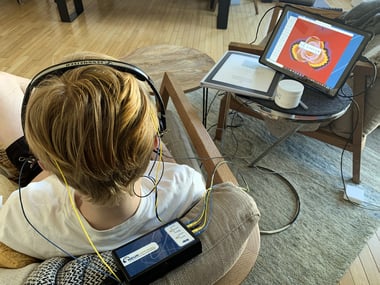
Similar to how biofeedback collects data about the brain indirectly through heart rate and skin temperature, neurofeedback is the process of collecting the brain's electrical communication through some data-collection device, most commonly EEG sensors and leads attached to the scalp.After measuring the electrical output, the data is fed into an amplifier and the voltage is given numerical values. Those numbers are then read by complex software to look for brain activity changes. Based on the design of the particular device's software, that data is used to provide feedback through auditory or visual cues, or both.
Based on the type of system, the feedback is used to condition the brain to shift out of the mal-adaptive brainwaves to more adaptive ones, or is used to cue the brain's organic self-balancing abilities. More on the different designs below, but first to review what is and isn't a neurofeedback device (that would make it more or less effective for change).
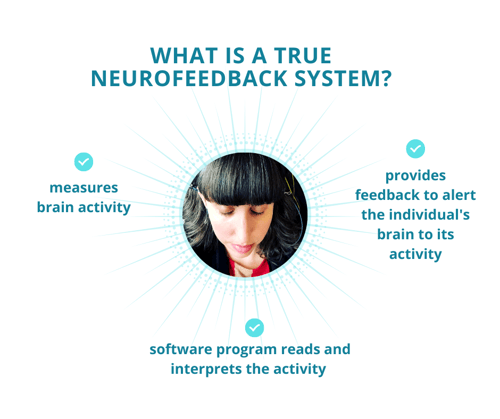
measuring brain activity, most commonly through Hz frequencies
a software program to read and interpret that activity
a system of feedback to alert the individual's brain to its activity
it does not measure the brain's electrical activity
there is no software interpreting the data in real-time
it does does not give feedback but rather adds something to the individual, the most common being micro-current stimulation to the scalp or neck.
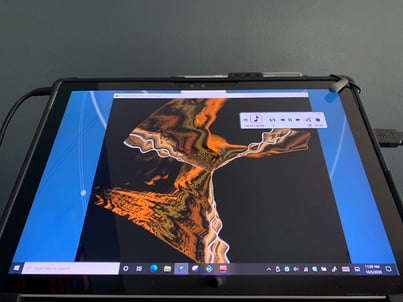
As mentioned in the introduction, if you want to do neurofeedback training at home the best is the fully automated system, which is the most recent advancement in the technology.
When neurofeedback devices were first created personal computers were not fast enough to operate at the speed of the human brain. As a consequence there needed to be an intermediary between the brain's output and the feedback.
This design is the first generation of neurofeedback where the trainer read the brain wave patterns of the client and assessed which ones were maladaptive and creating symptoms. The trainer then set protocols to entrain and migrate the brain to reset to adaptive brain waves.
The first generation, Protocol neurofeedback, can only be used in-office. The expert trainer uses brain mapping to set targets for adjusting the brain's frequencies during the training sessions. Then the trainer reassess periodically to see if adjustments need to be made to the targets. The trainer may use additional brain maps or client reports to know if new targets are needed. Adjustments may also be required if the client reports discomfort or unwanted changes, such as feeling more agitated.
Of the protocol-based systems there is one system, BrainPaint, which does allow home training, however, it requires the remote oversight by a trainer to monitor if the targets are correct.
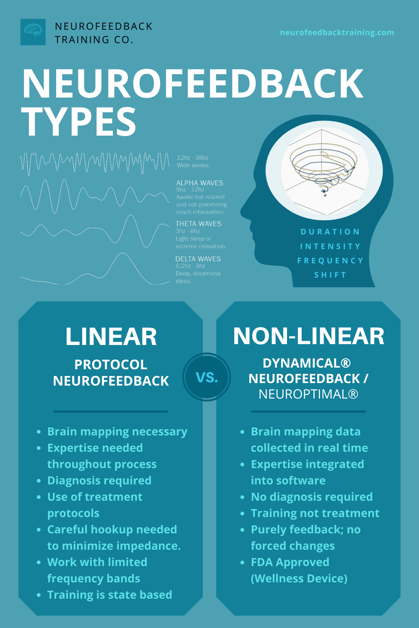
Besides the technological limitations as a constraint in the design, protocol or linear systems are based on a slightly different theory of brain health than the newer fully automated system, based on a non-linear design.
The older theory of brain health was that you needed the external expert deciding how the individual brain waves needed to change in order for symptoms to resolve. The process was to entrain and migrate, a form of conditioning, and through that 'nudging' the brain would shift brainwaves to reflect that of a 'normal' brain.
The limitations are that it assumed a linear model for a non-linear system (the brain). Though helpful, the trainer constantly needs to be reseting and refining the feedback for the trainee's brain so as to continue to see positive shifts and to prevent over training.
The majority of brain training devices are first generation protocol neurofeedback systems, and because there needs to be on-going assessment and resetting of protocols these systems are only used in an office setting and are not appropriate for home use.
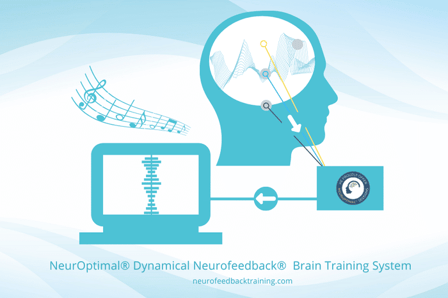 The latest generation of neurofeedback, called Dynamical Neurofeedback™, changed the design as the hardware technology improved. The intermediary was removed because the speed of computing power reached that of the brain so the feedback could happen in real-time.
The latest generation of neurofeedback, called Dynamical Neurofeedback™, changed the design as the hardware technology improved. The intermediary was removed because the speed of computing power reached that of the brain so the feedback could happen in real-time.
Updating the device design is an important feature when it comes to brain training because the field of brain health and wellness is ever changing and refining. As new information emerges about how the brain functions and, more importantly, how the brain heals itself through the process of neuroplasticity, the technology needs to change as well.
.png?width=449&name=WHAT%20IS%20A%20TRUE%20NEUROFEEDBACK%20SYSTEM_%20(1).png)
The second generation of neurofeedback has built-in software that communicates in real-time with the brain using dynamical, nonlinear mathematics. This system is fully automated and has removed the expert trainer, and replaced it with the true expert: the individual's brain.
Let's use the analogy of automobile technology to understand the history of neurofeedback: the first generation of cars had a manual crank starter, then we moved to a key and now we press a button to start the car. The latest technological leap is self-driving cars. In much the same way, neurofeedback technology advances as computer power increases. Over the decades, it has made leaps in how it operates and who can run sessions. Most recently, it has made the leap to automation.
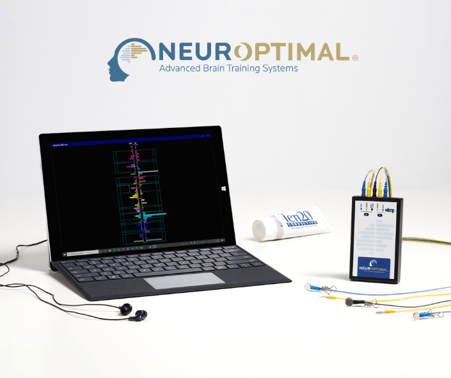 Currently the only fully automated system is NeurOptimal®, made by Zengar Institute. Their system became fully automated in 2010 and in 2018 the FDA designated NeurOptimal® as a General Wellness Product.
Currently the only fully automated system is NeurOptimal®, made by Zengar Institute. Their system became fully automated in 2010 and in 2018 the FDA designated NeurOptimal® as a General Wellness Product.
The NeurOptimal® system is the device we use for both in-office sessions and as home neurofeedback rentals because it is so easy to operate we know clients will be running safe and effective sessions on themselves and family members.
Because the technology creates a brain map millisecond by millisecond to be used to determine what needs to be optimized, each person training receives exactly the feedback their brain needs. Each session will be unique to the person's symptoms, as well as their changing needs from session to session.
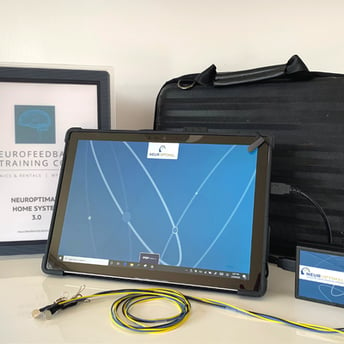 What’s included in the home unit rental? Do I need to purchase paste or anything separate?
What’s included in the home unit rental? Do I need to purchase paste or anything separate?Our rental plans include all materials required to train (including paste), access to online support forum moderated by expert trainers, access to regular check-ins with staff trainer via text, email, phone or Skype. We have found clients prefer to use their own headphones or earbuds so those are not included. Any headphones or earbuds are fine to use for the training.
We offer three different monthly plans to choose from. Depending on how many people will be training, and how many sessions you'd like to do we have a plan to meet your needs. A home session costs around $60 per session or with Unlimited plan pay only $30 per day. See our pricing here. We ship throughout U.S. and Canada at a low-cost and flat rate shipping fee which includes hassle-free return shipment and insurance.
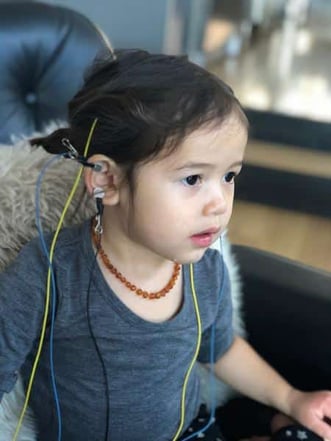
NeurOptimal® helps every brain perform at its best. Meltdowns is a sign that the child is under resourced and using primitive coping strategies to problem solve.
By doing the brain training, your child’s brain is learning to assess current needs from gathering information in the here-and-now, rather than using habitual information/neural pathways. An emotional meltdown is the result of maladaptive brain responses that are based on using habitual information/neural pathways to function not realizing that those responses are not appropriate to the present task. (For example, why should the brain produce an anxious state when there is no threat?) A major shift through training is your child’s brain learns to be in a state called regulation: calm, alert, and open to the here-and-now, and only become active only when their is an event that needs action.
Minimum time to rent the neurofeedback equipment is one month. However, the best results is by renting for 2 - 4 months depending on your goals. Watch our clients talk about their experience on the best uses of neurofeedback home system. After the first month's rental, one can choose to extend for another month or two weeks.
How to Get Best Results in Neurofeedback Training
It is very easy. Most customers are up and running sessions in 15 minutes. Watch this demonstration on how to operate the system and apply the five EEG sensors to your ears and scalp. Note: the sensor location is not precise, a rough measurement of half-way between the top of the ear and crown of the head is good.
We usually recommend 2-4 sessions per week per trainee, though you can train everyday too, as NeurOptimal® is a non-invasive brain training method. The minimum we recommend is once a week because through the training the brain is learning a new way of decision making and, like learning a new language, the more frequently the brain practices, the faster we learn.
No. While your brain will learn a lot about itself if you train every day for a month the value of spreading those trainings over two months is that it gives your behavior and thought patterns time to adapt.
For example, when the brain learns from the training that it doesn't need to stay in an anxious fight/flight pattern it will start to shift into calm. And in support of staying calm, the brain is going to 'ask' to hang out in less in highly anxious environments. So if we are used to working late and under-sleeping, which contributes to anxiety, we will want to start to shift our work and focus on getting the brain the rest it needs to function optimally.
That process of shifting behavior and the value system associated unfolds organically as one trains but giving ourselves time to make those changes is an important part of success.
This process changes occurring in the child's brain from training is sped up when a primary caregiver’s brain is also learning the same process of being regulated–calm, centered, open. Why? Because just like you see in pack animal behaviors, children’s brains tune themselves to their caregivers’ brains. If the parent is anxious, the child will also become anxious. If the parent becomes calm the child’s brain will also shift, like tuning forks resonating with each other. A wonderful example of this process of attunement is demonstrated in The Dog Whisperer on National Geographic. In the episodes you will see examples of how Cesar (the alpha dog trainer) who is “calm assertive”, i.e. has a regulated CNS, works with an anxious/fearful/aggressive dog through the natural attunement process where the dog's brain aligns with the calm assertive brain of the trainer.
Natalie Baker has over 25 years of experience as a licensed psychotherapist and has been a NeurOptimal® neurofeedback trainer since 2011. She is the founder of Neurofeedback Training Co., which offers in-person sessions and runs the largest nationwide home rental program for NeurOptimal systems. Natalie also teaches meditation and Buddhist psychology and specializes in working with anxiety, stress, ADHD, and trauma.
Want to try neurofeedback in Portland, Oregon but don't have time for the commute? Learn how renting NeurOptimal® home neurofeedback system will...
Does neurofeedback work? Is it a placebo effect? Learn the difference between non-linear and linear neurofeedback and the signs when it's working and...
Results from neurofeedback training: discover our client reviews of the NeurOptimal device. Learn the benefits of neurofeedback at home or office.
Be the first to know about new blogs